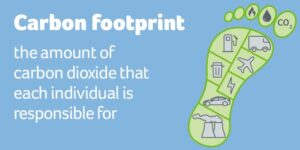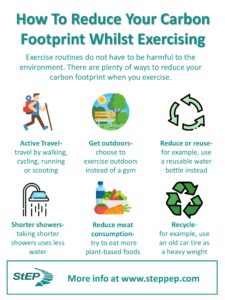Carbon footprint is the amount of carbon dioxide (CO2) emissions associated with all the activities of a person or other entity (e.g., building, corporation, country, etc.). It includes direct emissions, such as those that result from fossil-fuel combustion in manufacturing, heating, and transportation. Additionally, indirect emissions during the production of the electricity using coal and the consumed goods and associated services in this process.
In addition, the carbon footprint concept also often includes the emissions of other greenhouse gases, such as methane, nitrous oxide, and chlorofluorocarbons (CFCs). Many of our daily activities cause emissions of greenhouse gases. For example, we produce greenhouse gas emissions from burning gasoline when we drive, burning oil or gas for home heating, or using electricity generated from coal, natural gas, and oil.

Carbon footprint calculation:
A carbon footprint is usually expressed as a measure of weight, as in tons of CO2 or CO2 equivalent per year. We analyse the contribution of 8 categories: construction, shelter, food, clothing, mobility, manufactured products, services, and trade.
The per capita carbon footprint is highest in the United States. According to the Carbon Dioxide Information Analysis Centre and the United Nations Development Programme, in 2004 the average resident of the United States had a per capita carbon footprint of 20.6 metric tons (22.7 short tons) of CO2 equivalent, some five to seven times the global average. Averages vary greatly around the world, with higher footprints generally found in residents of developed countries. For example, that same year France had a per capita carbon footprint of 6.0 metric tons (6.6 short tons), whereas Brazil and Tanzania had carbon footprints of 1.8 metric tons (about 2 short tons) and 0.1 metric ton (0.1 short ton) of CO2 equivalent, respectively.
Carbon footprint reduction:
Individuals and corporations must take a number of steps to reduce their carbon footprints and thus contribute to global climate mitigation. They can purchase carbon offsets (broadly stated, an investment in a carbon-reducing activity or technology) to compensate for part or all of their carbon footprint. If they purchase enough to offset their carbon footprint, they become effectively carbon neutral.
Carbon footprints can be reduced through improving energy efficiency, changing lifestyles, and purchasing habits. Switching personal energy and transportation use can have an impact on primary carbon footprints. For example, using public transportation, such as buses and trains, reduces an individual’s carbon footprint when compared to self-driving. Individuals and corporations can reduce their respective carbon footprints by installing energy-efficient lighting, adding insulation in buildings, or using renewable energy sources to generate the required electricity. For example, electricity generation from wind power produces no direct carbon emissions. Additional lifestyle choices that can lower an individual’s secondary carbon footprint include reducing consumption of meat and switching purchasing habits to products that require fewer carbon emissions to produce and transport.
Some simple steps to reduce personal carbon footprint are suggested in following list:

1. TRANSPORTATION
• Avoid polluting car and plane journeys (each litre of fuel burnt in a car engine emits over 2.5 kg of CO2).
• Favour walking, cycling, or using public transport, especially trains and metros that run using hydroelectric power.
2. FOOD
• Reduce the consumption of animal products as cattle produce greenhouse gases.
• Eat local and seasonally produced foods as short trips mean less pollution from transportation.
• Recycle/ compost organic waste. Otherwise, methane will be released by the decomposing biodegradable waste in landfills.
4. WATER USE
• Use the washing machine and dishwasher only when adequate clothes or dishes are piled up.
• Boil the water absolutely required and cover the utensils while cooking food to save plenty of energy and fasten up the process.
• Harvest rainwater from a rooftop as an alternative to groundwater.
• Raise hand pumps to protect drinking-water from flood contamination.
5. ENERGY USE
• Be mindful of the temperature of electrical and electronic gadgets, heating or cooling elements at house or office. Even 1ºC low temperature will reduce emissions (and your energy bill) by 5-10%;
• Improve your house’s insulation so that less heat gets out when it is cold and less heat comes in when it is warm. This reduces the need to use other air conditioning devices.
• Change electricity supplier for a greener one that provides greener (renewable) energy so that low carbon energy sources are utilised.
6. WASTE MANAGEMENT
• Refuse to buy the items that are not essential, reduce the usage of items that are essential, reuse the items as many times as possible, repurpose the items that are no longer being used, and recycle or compost the items that reach the end of their lifecycle.
• Avoid buying plastic bags to transport your shopping items by reusing eco-friendly and biodegradable shopping bags such as cotton canvas bags.
• Choose products with little/no packaging which will ultimately cut down the production costs.
